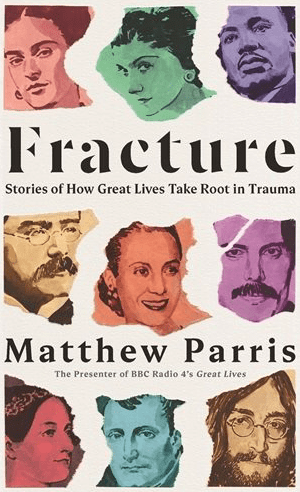Arpan K. Banerjee
Solihull, United Kingdom

Cover of Fracture: Stories of How Great Lives Take Root in Trauma by Matthew Parris, 2020.
The lives of people who seem to be endowed with extraordinary abilities have long been a source of fascination. The famous Italian physician, researcher, and founder of the science of criminology, Cesare Lombroso, professed this interest in his 1889 book The Man of Genius, stating that genius was a form of madness. Although this belief has not been supported by modern research, the subject of high achievement and genius continues to be an area of much inquiry and speculation.
Matthew Parris, a former British Member of Parliament and distinguished writer, has presented a radio series entitled “Great Lives,” in which he examines the lives of people who have made outstanding contributions in science, politics, literature, art, sports, and music. One characteristic held in common is an experience of some type of trauma, which may have moved these individuals to achieve great things. Nietzsche said, “That what does not kill you makes you strong,” and Parris argues that experiences of isolation, chaos, family dysfunction, cruelty, prejudice, oppression, and physical and mental illness in the self or family may actually foster the emergence of genius.
We learn about Carl Jung’s mother going mad, which may have spurred Jung to become interested in psychology. Ada Lovelace, the mathematical genius, suffered from family breakdown when her parents divorced, physical illnesses throughout her childhood, and mood swings resulting from a childhood starved of affection and exacerbated by opiates prescribed for pain relief. Frida Kahlo, the Mexican painter, had many injuries and operations in her life, which resulted in constant physical pain that is also brilliantly depicted in her works.
Childhood isolation was a common factor for designer Coco Chanel, filmmakers Charlie Chaplin and Orson Welles, and singer Freddie Mercury, all of whom were remarkably successful in their fields. Family dysfunction was a driving force in the lives of Abraham Lincoln, John Lennon, and Eva Peron. The experience of racial prejudice was formative for Martin Luther King and Muhammad Ali, and Marie Curie experienced prejudice from the scientific community because she was female. The experience of cruelty in their youth drove the Bronte sisters to subsequent great literary achievement.
This book is well-written and Parris argues his case well for the influence of early traumatic experiences on lives of subsequent achievement. Genius continues to fascinate and this volume provides an illuminating peek into the lives of some of these remarkable humans.
Fracture: Stories of How Great Lives Take Root in Trauma
Matthew Parris, 2020
Profile Books
ISBN 9781781257234
ARPAN K. BANERJEE, MBBS (LOND), FRCP, FRCR, FBIR, qualified in medicine at St. Thomas’s Hospital Medical School, London. He was a consultant radiologist in Birmingham from 1995–2019. He served on the scientific committee of the Royal College of Radiologists 2012–2016. He was Chairman of the British Society for the History of Radiology from 2012–2017. He is Treasurer of ISHRAD and adviser to Radiopaedia. He is the author/co-author of numerous papers and articles on a variety of clinical medical, radiological, and medical historical topics and seven books including Classic Papers in Modern Diagnostic Radiology (2005) and The History of Radiology (OUP 2013).

Leave a Reply